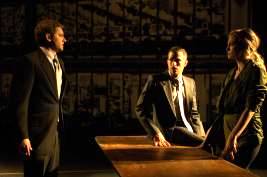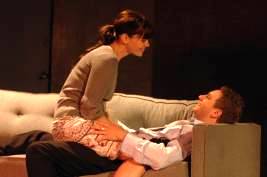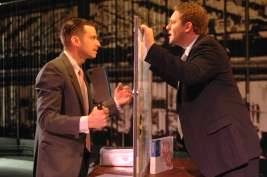RECOMMENDED
Anyone thirty-five or older can remember a time in their teenage or adult lives when they functioned quite well without the Internet or a cell phone. Those days are long gone, prompting most of us of a certain age to wonder how we ever did without. Our lives have become so technology-dependent that that if a person’s cell phone doesn’t have Internet access (heaven forbid!), he or she is seriously behind the times. (I need to get with it on this!)
Matthew Benjamin and Logan Brown’s world premiere comedy thriller Wirehead imagines a not-so-distant future in which microscopic telephones are hidden in a person’s mouth—inside a lower molar to be more precise, thereby providing sound directly to the ear canal. Even more remarkable are the with-it folk called Wireheads. These formerly average, everyday humans have literally been wired to think and perform at breakneck speed, thereby leapfrogging over fellow workers to promotion after promotion.
It’s inside this world that Adams (Jeremy Maxwell) and Destry (Marc Rose) exist, two office workers in adjoining cubicles who pass the time complaining about their Wirehead colleague Hammy (Riel Paley).
The day finally comes when Destry has had enough of Hammy’s bragging (“I know so much, I don’t even know what I know!”), and in the course of a physical tussle with his nemesis, rips the wire from out of Hammy’s ear, thereby removing a bit of his brain and effectively ending the Wirehead’s life. “I had no idea it would be that long,” exclaims the accidental killer. “How the hell did they get that thing in his brain?” Adams is considerably less nonchalant than his coworker about what has just transpired. He wants to take Hammy to the hospital. Destry disagrees. “It’s just a really stupid thing,” he avers. “It was a happy accident, like penicillin. A mistake.”
If Wirehead sounds more than a bit confusing and more than a bit bizarre, you’re right. Though the play maintains Echo Theater Company’s high standards of acting, directing, and design, a problematic script prevents it from attaining the all-around excellence that made 2008’s Body Politic one of the best dramatic productions of the year.
Playwrights Benjamin and Brown are clearly concerned about the effect of technology on our society, but there are a couple ways they could make Wirehead a more effective piece of writing.
a) Give the audience a reason to care.
Though the actors’ work couldn’t be better, I was unable to figure out what either Rip or Adams wanted, or had at stake, in trying to rid the world of Wireheads. Thus, I ended up a cool observer rather than an involved one. Their names seemed so infrequently mentioned that I didn’t even know what to call them in my mind. Later, when their girlfriends Monyca (Amanda Saunders) and Laura (Samantha Shelton) were introduced, it was more because of Shelton’s likeable, girl-next-door quality that I felt drawn to Laura than anything inherent in the script itself.
b) Work on making Wirehead’s plot clearer and more coherent.
A few examples: At the end of the first act, Rip and Adams pop up in fake wigs and mustaches to confront a new character, an auto mechanic named Jeremiah. The disguises were never explained, nor was it made clear why these two heterosexual friends were seemingly taken by Jeremiah’s good looks. Then there’s a splatter flick sequence that pops up in the second act that seems to come out of nowhere, almost as if from another play, and it was unclear what the whole meat cleaver thing was about. And what about those red sheets of notebook paper? Perhaps other audience members got all this, but this reviewer didn’t.
On the plus side, director Larry Biederman has done the same kind of imaginative, dynamic work that he did in last year’s La Ronde. Maxwell and Rose both give intense, committed performances, Shelton creates a real, three-dimensional character, and Saunders is very funny as the self-centered Monyca (accent on the second syllable, please). Paley effectively creates three different characters, Hammy, Jeremiah, and the boys’ boss. Ethan Phillips is all afire as shock jock Rip, whose radio call-ins are interspersed between scenes, though I found these sequences more grating than anything else.
Besides the production’s crackerjack acting, its design too, all shades of white and gray, makes Wirehead worth a look-see. Efren Delgadillo, Jr.’s set works wonders with Stage 52’s wide, wide wedge-shaped stage. The back wall is covered by reversible vertical blinds, and translucent panels slide this way and that, behind which silhouettes of callers to Rip’s radio program are lit by Dan Weingarten’s stark, dramatic lighting. Kudos too to the uncredited splatter projections. Drew Dalzell has created a particularly dramatic, high-tech sound design, and Audrey Eisner’s costumes are just right for each character.
Audience members more fond than I am of the sci-fi, futuristic fantasy genre may take to Wirehead more than I did. One thing at least is undeniable. Echo Theater Company is one of L.A.’s best, and most daring young theater ensembles.
Stage 52, 5299 W. Washington Boulevard, Los Angeles. www.echotheatercompany.com
–Steven Stanley
February 21, 2010
Photos: Cathryn Farnsworth






 Since 2007, Steven Stanley's StageSceneLA.com has spotlighted the best in Southern California theater via reviews, interviews, and its annual StageSceneLA Scenies.
Since 2007, Steven Stanley's StageSceneLA.com has spotlighted the best in Southern California theater via reviews, interviews, and its annual StageSceneLA Scenies.







 COPYRIGHT 2024 STEVEN STANLEY :: DESIGN BY
COPYRIGHT 2024 STEVEN STANLEY :: DESIGN BY